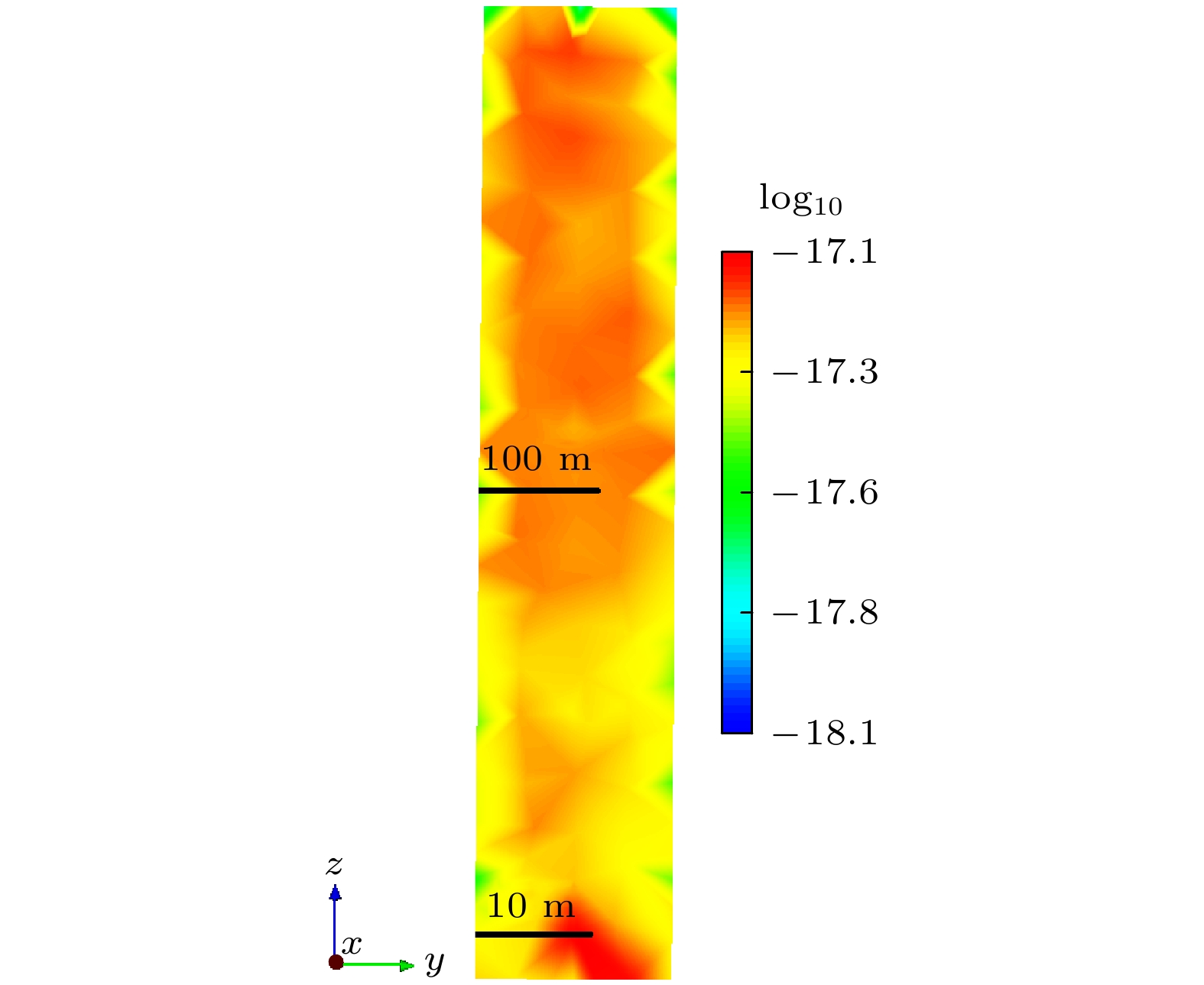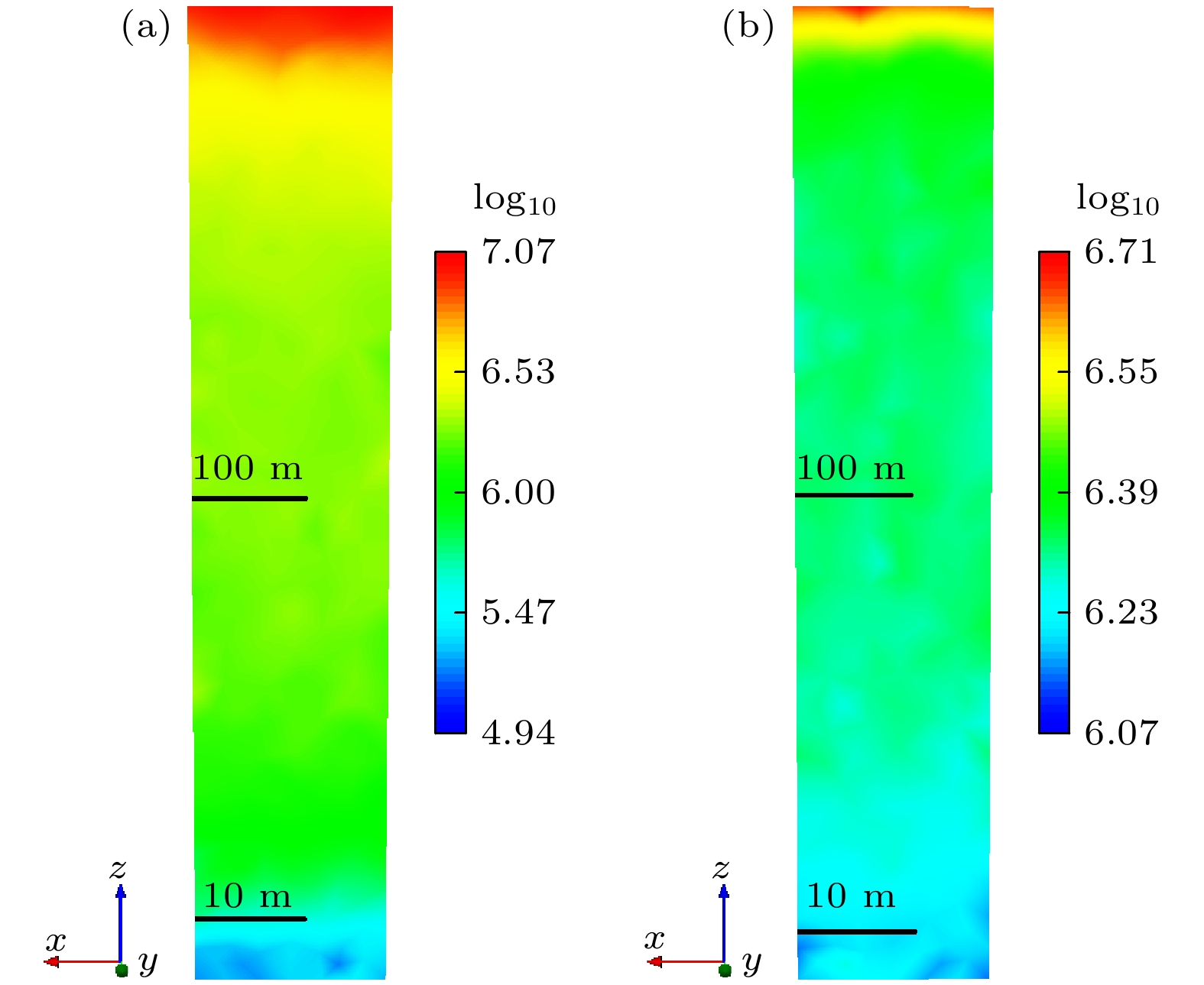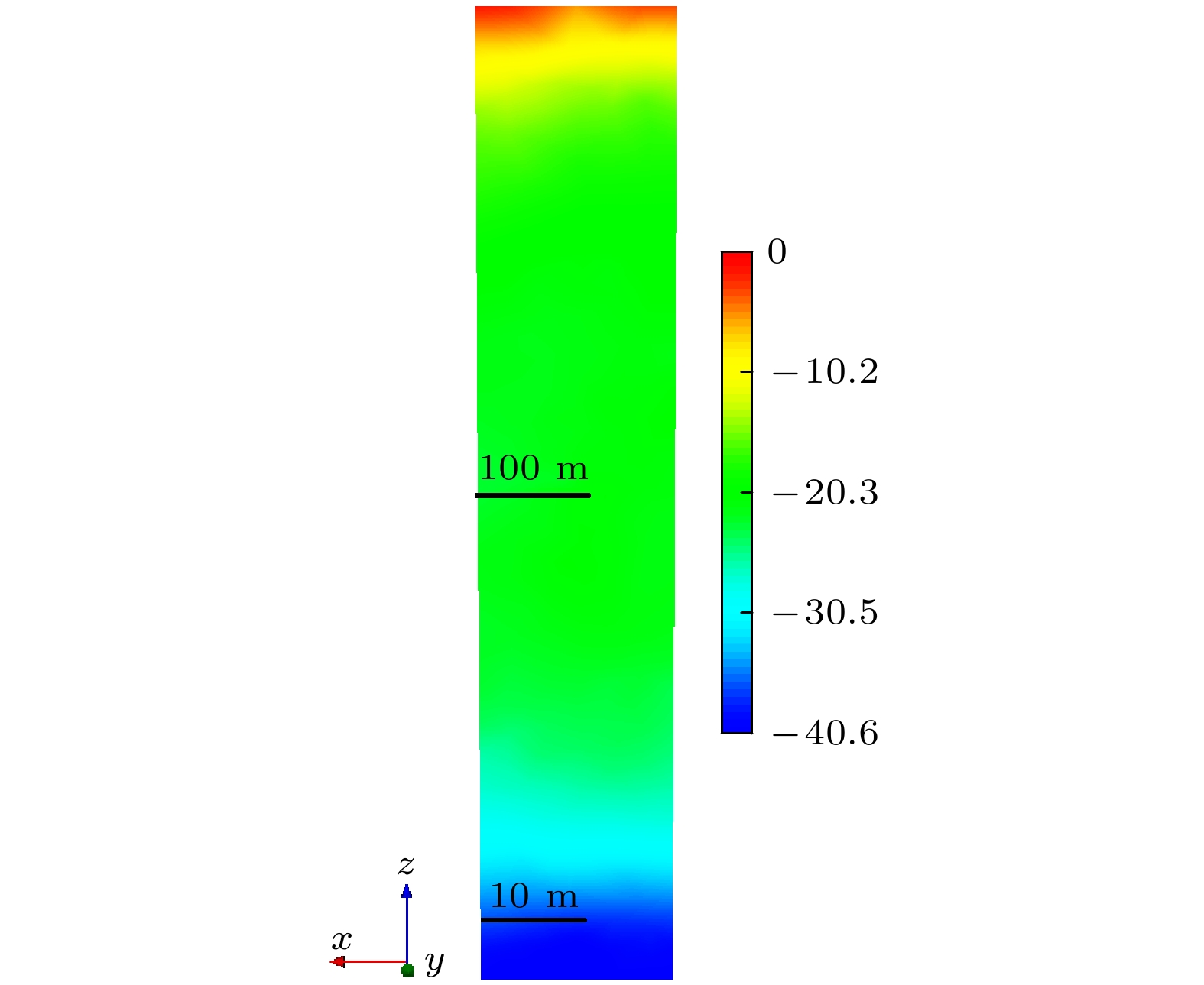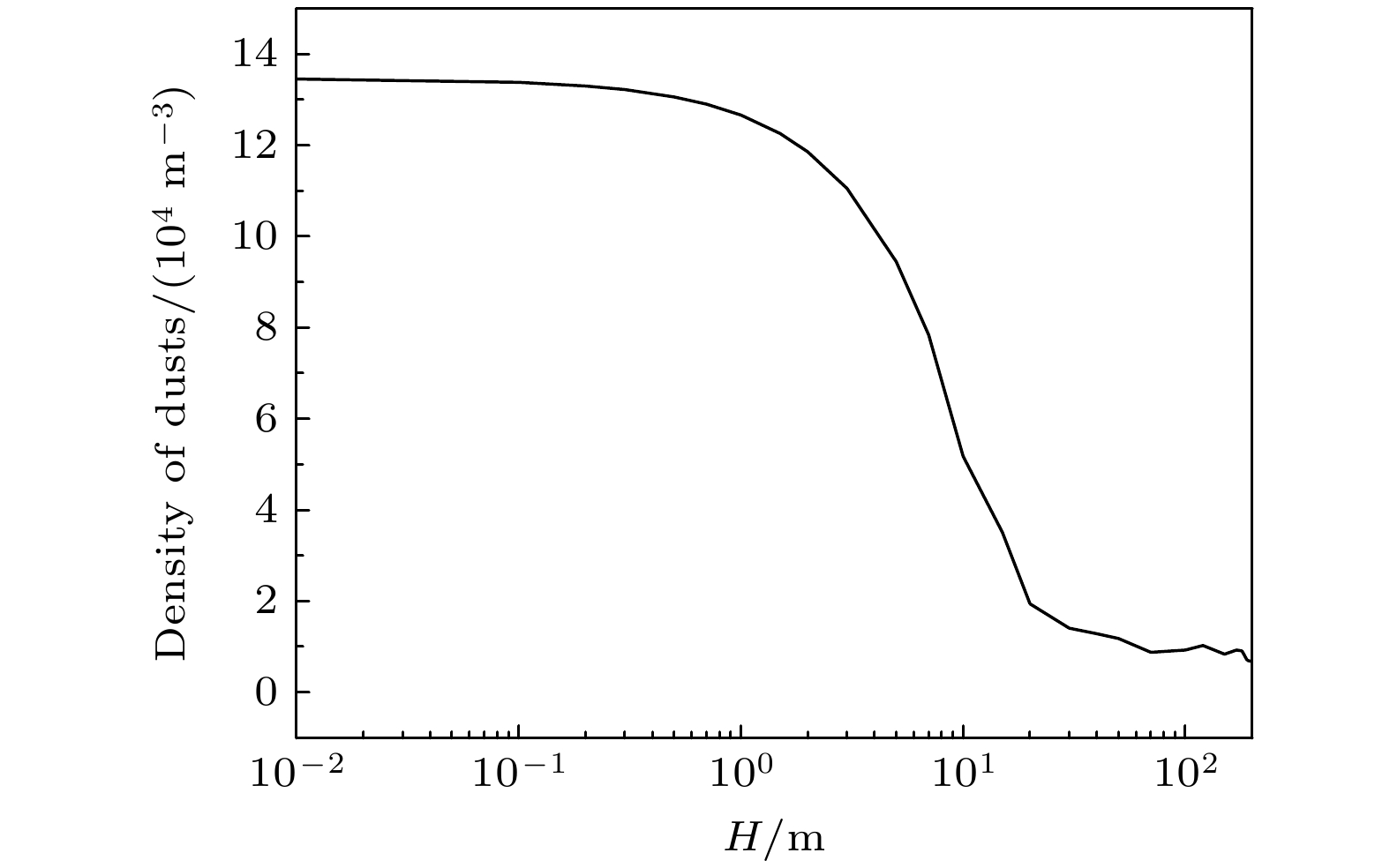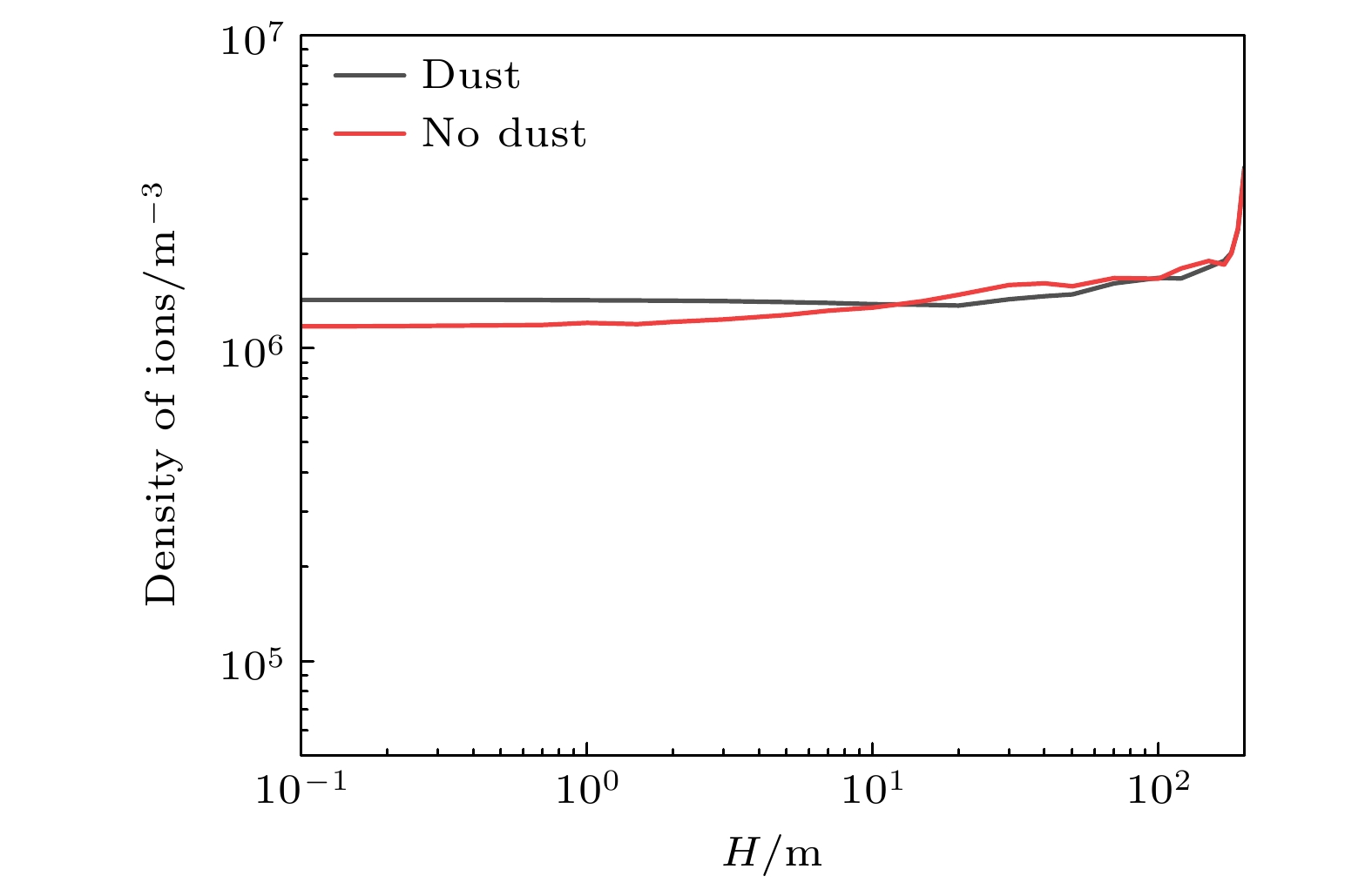-
由于缺少大气和全球性磁场的保护, 空间等离子体环境可直接作用于月球表面的月壤层, 月壤中较小粒径的月尘带电后会在月面附近形成复杂的尘埃等离子体环境, 影响探月任务的顺利实施. 针对月球南极尘埃等离子体环境, 本文利用SPIS (spacecraft plasma interactions software)软件, 仿真研究了月球南极0—200 m高度范围的等离子体和月尘的空间分布情况及月面充电特性, 揭示了月面附近尘埃等离子体环境特征及悬浮在月面附近的带电月尘对等离子体环境的影响. 仿真结果与Apollo探测数据和Popel团队的理论数据吻合. 研究结果: 表明空间电位随着高度升高而增加, 月球南极附近0—10 m电位约为–40 V, 在100 m处空间电位约为–20 V; 在10 m以下高度范围内月尘密度为107.22—104.66 m–3; 月表附近尘埃等离子体中的电子密度为105.47 m–3, 离子密度为106.07 m –3, 并随着高度升高而增大; 带电月尘会影响月尘的空间分布, 主要是通过影响空间电场的分布, 进而导致电子分布差异, 对离子的影响不大.Unlike the Earth, the Moon lacks is not protected from the atmosphere and global magnetic field, and will be directly exposed to complex radiation environments such as high-energy cosmic rays, solar wind, and the Earth’s magnetotail plasma. The surface of the Moon is covered with a thick layer of lunar soil, and the particles in the soil with a diameter between 30 nm–20 μm are called lunar dust. In the complex environments such as solar wind or magnetotail plasma, lunar dust carries an electric charge and becomes charged lunar dust. Charged lunar dust is prone to migration under the action of the electric field on the lunar surface. Charged migrated lunar dust is easy to adhere to the surface of instruments and equipment, resulting in visual impairment, astronauts’ movement disorders, equipment mechanical blockage, sealing failure, and material wear, which affects the lunar exploration mission. As an important lunar exploration landing site, the lunar south pole receives special solar radiation and produces a special dust plasma environment due to its special location. In order to provide an environmental reference for lunar south pole exploration, it is necessary to explore the characteristics of the dust plasma environment in the lunar south pole and its impact. In view of the lunar south pole environment, The Spacecraft Plasma Interactions Software (SPIS) software developed by the European Space Agency is used to carry out modelling and simulation in this work. Through the simulation, the logarithmic distribution of the lunar dust space density in a range of 0–200 m at the lunar south pole, the potential distribution near the lunar surface, and the spatial distribution characteristics of plasma electrons and ions are obtained. The obtained lunar dust space density and lunar surface potential are similar to the previous theoretical derivation and field detection data, so the simulation results have high reliability. The spatial potential distribution and the spatial density distribution of electrons and ions in the lunar environment with and without lunar dust are compared. Finally, the conclusions can be drawn as follows. The space potential increases with altitude increasing. The potential at 0–10 m near the lunar south pole is about –40 V, and the space potential at 100 m is about –20 V. The density of lunar dust in an altitude range below 10 m is 107.22 m–3–104.66 m–3. The electron density in the dust plasma near the lunar surface is 105.47 m–3, and the ion density is 106.07 m–3, and both increase with altitude increasing. Charged lunar dust affects the spatial distribution of lunar dust, mainly through affecting the distribution of the space electric field, which leads to difference in electron distribution, but has little effect on ions.
-
Keywords:
- lunar south pole /
- dust plasma environment /
- SPIS simulation /
- lunar surface potential distribution
[1] Zhang S S, Wang S J, Li X Y, Li S J, Tang H, Li Y, Yu W 2013 J. Earth. Sci. 38 339
 Google Scholar
Google Scholar
[2] Gaier J R 2007 The Effects of Lunar Dust on EVA Systems During the Apollo Missions NASA Technical Report TM-2005-213610
[3] Park J, Liu Y, Kihm K D, Hill E, Taylor L A 2006 Earth & Space 2006: Engineering, Construction, and Operations in Challenging Environment (Houston: American Society of Civil Engineers) p1
[4] Horányi M, Szalay J R, Wang X 2024 Phil. Trans. R. Soc. A. 382 20230075
 Google Scholar
Google Scholar
[5] Sickafoose A A, Colwell J E, Horányi M, Robertson S 2001 Geophys. Res. Space Phys. 106 8343
 Google Scholar
Google Scholar
[6] Sickafoose A A, Colwell J E, Horányi M, Robertson S 2002 Geophys. Res. Space Phys. 107 SMP 37-1
 Google Scholar
Google Scholar
[7] Sternovsky Z, Robertson S, Sickafoose A, Colwell J, Horányi M 2002 J. Geophys. Res. Planets. 107 15
 Google Scholar
Google Scholar
[8] Colwell J E, Robertson S R, Horányi M, Wang X, Poppe A, Wheeler P 2009 J. Aerosp. Eng. 22 2
 Google Scholar
Google Scholar
[9] Colwell J E, Batiste S, Horányi M, Robertson S, Sture S 2007 Rev. Geophys. 45 RG2006
 Google Scholar
Google Scholar
[10] Wang X, Schwan J, Hsu H W, Grün E, Horányi M 2016 Geophys. Res. Lett. 43 6103
 Google Scholar
Google Scholar
[11] Popel S I, Zelenyi L M 2013 J. Plasma Phys. 79 405
 Google Scholar
Google Scholar
[12] Popel S I, Golub’ A P, Izvekova Y N, Afonin V V, Dol’nikov G G, Zakharov A V, Petrov O F 2014 JETP Lett. 99 115
 Google Scholar
Google Scholar
[13] Popel S I, Golub’ A P, Zelenyi L M 2014 Eur. Phys. J. D. 68 245
 Google Scholar
Google Scholar
[14] Popel S I, Golub’ A P, Lisin E A, Izvekova Y N, Atamaniuk B, Dol’nikov G G, Zelenyi L M 2016 JETP Lett. 103 563
 Google Scholar
Google Scholar
[15] Popel S I, Golub’ A P, Zelenyi L M, Horányi M 2017 JETP Lett. 105 635
 Google Scholar
Google Scholar
[16] Popel S I, Zelenyi L M, Dubinskii A Y 2018 Planet. Space Sci. 156 71
 Google Scholar
Google Scholar
[17] Popel S I, Zelenyi L M 2014 J. Plasma. Phys. 80 885
 Google Scholar
Google Scholar
[18] Anuar A K 2013 Ph. D. Dissertation (United Kingdom: Lancaster University
[19] Sternovsky Z, Chamberlin P, Horanyi M, Robertson S, Wang X 2008 J. Geophys. Res. Space Phys. 113 A10104
 Google Scholar
Google Scholar
[20] Robertson S H, Sternovsky Z, Horanyi M 2010 IEEE. Trans. Plasma. Sci. 38 766
 Google Scholar
Google Scholar
[21] Hartzell C M, Bellan P, Bodewits D, Delzanno G L, Hirabayashi M, Hyde T, Israelsson U 2023 Acta. Astronaut. 207 89
 Google Scholar
Google Scholar
[22] Xie L H, Zhang X, Li L, Zhou B, Zhang Y, Yan Q, Yu S, Feng Y, Guo D, Yu S 2020 Geophys. Res. Lett. 47 e2020GL089593
 Google Scholar
Google Scholar
[23] Zhao C X, Gan H, Xie L H, Wang Y, Wang Y J, Hong J Y 2023 Sci. China Earth Sci. 66 2278
 Google Scholar
Google Scholar
[24] Hess S L G, Sarrailh P, Matéo-Vélez J C, Jeanty-Ruard B, Cipriani F, Forest J, Rodgers D 2015 IEEE. Trans. Plasma. Sci. 43 2799-2807
 Google Scholar
Google Scholar
[25] Dyadechkin S, Kallio E, Wurz P 2015 J. Geophys. Res. Space Physics. 120 1589
 Google Scholar
Google Scholar
[26] SPIS-DUST Detailed Design Document and Software User Manual_v2, Sarrailh P, Hess S, Mateo Velez J C, Jeanty Ruard B, Forest J https://www.spis.org/software/spis/documentation/ [2024-4-30]
[27] Halekas J S, Delory G T, Lin R P, Stubbs T J, Farrell W M 2008 J. Geophys. Res. Space Phys. 113 A09102
 Google Scholar
Google Scholar
[28] Williams J P, Paige D A, Greenhagen B T, Sefton-Nash E 2017 Icarus. 283 300
 Google Scholar
Google Scholar
[29] De Rosa D, Bussey B, Cahill J T, Lutz T, Crawford I A, Hackwill T, Carpenter J D 2012 Planet. Space Sci. 74 224
 Google Scholar
Google Scholar
[30] Freeman J W, Ibrahim M 1975 Lunar Science Institute, Conference on Interactions of the Interplanetary Plasma with the Modern and Ancient Moon Lake Geneva, Wis, September 30–October 4, 1974 p103
-
-
[1] Zhang S S, Wang S J, Li X Y, Li S J, Tang H, Li Y, Yu W 2013 J. Earth. Sci. 38 339
 Google Scholar
Google Scholar
[2] Gaier J R 2007 The Effects of Lunar Dust on EVA Systems During the Apollo Missions NASA Technical Report TM-2005-213610
[3] Park J, Liu Y, Kihm K D, Hill E, Taylor L A 2006 Earth & Space 2006: Engineering, Construction, and Operations in Challenging Environment (Houston: American Society of Civil Engineers) p1
[4] Horányi M, Szalay J R, Wang X 2024 Phil. Trans. R. Soc. A. 382 20230075
 Google Scholar
Google Scholar
[5] Sickafoose A A, Colwell J E, Horányi M, Robertson S 2001 Geophys. Res. Space Phys. 106 8343
 Google Scholar
Google Scholar
[6] Sickafoose A A, Colwell J E, Horányi M, Robertson S 2002 Geophys. Res. Space Phys. 107 SMP 37-1
 Google Scholar
Google Scholar
[7] Sternovsky Z, Robertson S, Sickafoose A, Colwell J, Horányi M 2002 J. Geophys. Res. Planets. 107 15
 Google Scholar
Google Scholar
[8] Colwell J E, Robertson S R, Horányi M, Wang X, Poppe A, Wheeler P 2009 J. Aerosp. Eng. 22 2
 Google Scholar
Google Scholar
[9] Colwell J E, Batiste S, Horányi M, Robertson S, Sture S 2007 Rev. Geophys. 45 RG2006
 Google Scholar
Google Scholar
[10] Wang X, Schwan J, Hsu H W, Grün E, Horányi M 2016 Geophys. Res. Lett. 43 6103
 Google Scholar
Google Scholar
[11] Popel S I, Zelenyi L M 2013 J. Plasma Phys. 79 405
 Google Scholar
Google Scholar
[12] Popel S I, Golub’ A P, Izvekova Y N, Afonin V V, Dol’nikov G G, Zakharov A V, Petrov O F 2014 JETP Lett. 99 115
 Google Scholar
Google Scholar
[13] Popel S I, Golub’ A P, Zelenyi L M 2014 Eur. Phys. J. D. 68 245
 Google Scholar
Google Scholar
[14] Popel S I, Golub’ A P, Lisin E A, Izvekova Y N, Atamaniuk B, Dol’nikov G G, Zelenyi L M 2016 JETP Lett. 103 563
 Google Scholar
Google Scholar
[15] Popel S I, Golub’ A P, Zelenyi L M, Horányi M 2017 JETP Lett. 105 635
 Google Scholar
Google Scholar
[16] Popel S I, Zelenyi L M, Dubinskii A Y 2018 Planet. Space Sci. 156 71
 Google Scholar
Google Scholar
[17] Popel S I, Zelenyi L M 2014 J. Plasma. Phys. 80 885
 Google Scholar
Google Scholar
[18] Anuar A K 2013 Ph. D. Dissertation (United Kingdom: Lancaster University
[19] Sternovsky Z, Chamberlin P, Horanyi M, Robertson S, Wang X 2008 J. Geophys. Res. Space Phys. 113 A10104
 Google Scholar
Google Scholar
[20] Robertson S H, Sternovsky Z, Horanyi M 2010 IEEE. Trans. Plasma. Sci. 38 766
 Google Scholar
Google Scholar
[21] Hartzell C M, Bellan P, Bodewits D, Delzanno G L, Hirabayashi M, Hyde T, Israelsson U 2023 Acta. Astronaut. 207 89
 Google Scholar
Google Scholar
[22] Xie L H, Zhang X, Li L, Zhou B, Zhang Y, Yan Q, Yu S, Feng Y, Guo D, Yu S 2020 Geophys. Res. Lett. 47 e2020GL089593
 Google Scholar
Google Scholar
[23] Zhao C X, Gan H, Xie L H, Wang Y, Wang Y J, Hong J Y 2023 Sci. China Earth Sci. 66 2278
 Google Scholar
Google Scholar
[24] Hess S L G, Sarrailh P, Matéo-Vélez J C, Jeanty-Ruard B, Cipriani F, Forest J, Rodgers D 2015 IEEE. Trans. Plasma. Sci. 43 2799-2807
 Google Scholar
Google Scholar
[25] Dyadechkin S, Kallio E, Wurz P 2015 J. Geophys. Res. Space Physics. 120 1589
 Google Scholar
Google Scholar
[26] SPIS-DUST Detailed Design Document and Software User Manual_v2, Sarrailh P, Hess S, Mateo Velez J C, Jeanty Ruard B, Forest J https://www.spis.org/software/spis/documentation/ [2024-4-30]
[27] Halekas J S, Delory G T, Lin R P, Stubbs T J, Farrell W M 2008 J. Geophys. Res. Space Phys. 113 A09102
 Google Scholar
Google Scholar
[28] Williams J P, Paige D A, Greenhagen B T, Sefton-Nash E 2017 Icarus. 283 300
 Google Scholar
Google Scholar
[29] De Rosa D, Bussey B, Cahill J T, Lutz T, Crawford I A, Hackwill T, Carpenter J D 2012 Planet. Space Sci. 74 224
 Google Scholar
Google Scholar
[30] Freeman J W, Ibrahim M 1975 Lunar Science Institute, Conference on Interactions of the Interplanetary Plasma with the Modern and Ancient Moon Lake Geneva, Wis, September 30–October 4, 1974 p103
计量
- 文章访问数: 5985
- PDF下载量: 96
- 被引次数: 0














 下载:
下载:

